ASUS E35M1-M Pro Review - Anyone For Fusion?
by Brendan van Varik on October 25, 2011 5:00 AM EST- Posted in
- Asus
- Motherboards
- Fusion
- E-350
LAN Speed Test
LAN Speed Test is a freeware program designed for testing the network connection between two PCs on a home network. The speed of the transfer is limited by the lowest common denominator on the network, so if you have gigabit Ethernet capable computers but a 100 Mbit capable router, you are limited to 100 Mbit transfer. Note that this is really a formality – if a network port is rated at 1 Gbps, then chances are that it will hit at least 90+% of this value. The main test here is CPU usage, and how much is offloaded by the controller. For this test, we use LAN Speed Test to transfer a 1000 MB file across a home network with a 1000 Mbps lowest common speed to the same machine each time, in a read/write scenario.
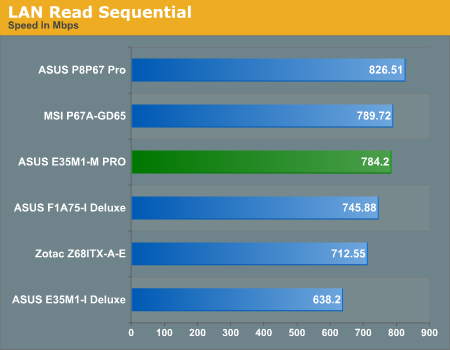
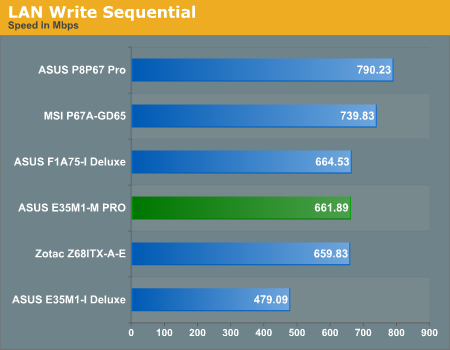
As we only have two results on the A50M platform which were tested under a 1 Gbps environment, I have decided to compare it to a few other platforms too. LAN throughput should be down to the onboard chip and therefore it has been compared to these platforms. Judging by the read and write speeds, the E35M1-M Pro does well for itself and is above average in the read tests but falls just under the average marker with the write tests.
USB Speed
For this benchmark, we run CrystalDiskMark to determine the ideal sequential read and write speeds for the USB port using our 64GB Patriot SuperSpeed USB 3.0 drive. Then we transfer a set size of files from the SSD to the USB drive, and monitor the time taken to transfer. The files transferred are a 1.52 GB set of 2867 files across 320 folders – 95% of these files are small typical website files, and the rest (90% of the size) are the videos used in the Sorenson Squeeze test.

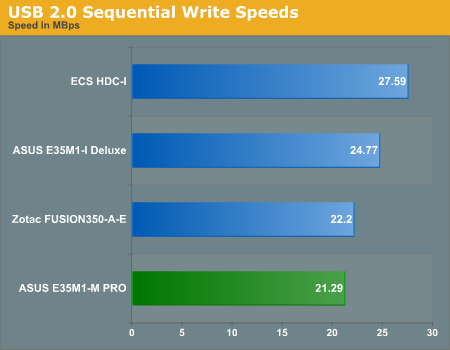
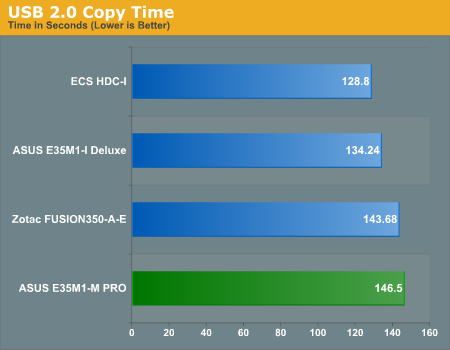
The USB 2.0 read speeds are above average out of the four boards but the writes on the other hand come in at bottom place. The reason for this is unknown.
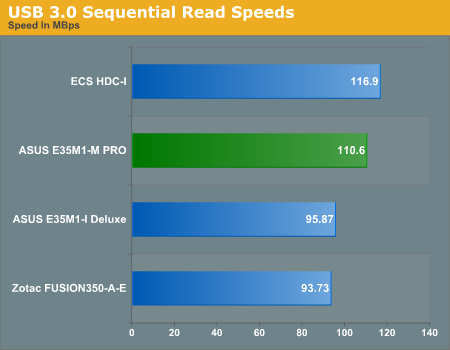

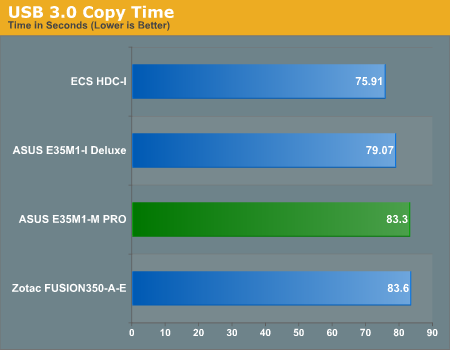
Write speeds on the USB 3.0 side of things are much better than the USB 2.0 results and the read speeds are above average here as well.
SATA Testing
We also use CrystalDiskMark for SATA port testing. The operating system is installed on the OCZ Vertex 3 240GB SSD, which is rated at up to 550 MB/s read and up to 520 MB/s write, and the sequential test is run at the 5 x 1000 MB level on a separate clean partition. This test probes the efficiency of the data delivery system between the chipset and the drive, or in the case of additional SATA ports provided by a third party controller, the efficiency between the controller, the chipset and the drive.


In the Vertex 3 testing the board got the fastest read speeds for A50M but the write speeds were below average. It is debatable whether a user would notice this is regular usage for this board, however.
DPC Latency
Deferred Procedure Call latency is a way in which Windows handles interrupt servicing. In order to wait for a processor to acknowledge the request, the system will queue all interrupt requests by priority. Critical interrupts will be handled as soon as possible, whereas lesser priority requests, such as audio, will be further down the line. So if the audio device requires data, it will have to wait until the request is processed before the buffer is filled. If the device drivers of higher priority components in a system are poorly implemented, this can cause delays in request scheduling and process time, resulting in an empty audio buffer – this leads to characteristic audible pauses, pops and clicks. Having a bigger buffer and correctly implemented system drivers obviously helps in this regard. The DPC latency checker measures how much time is processing DPCs from driver invocation – the lower the value will result in better audio transfer at smaller buffer sizes. Results are measured in microseconds and taken as the peak latency while cycling through a series of short HD videos - under 500 microseconds usually gets the green light, but the lower the better.

The E35M1-M PRO currently holds the lowest DPC Latency score in our records for the A50M platform.










66 Comments
View All Comments
hackztor - Tuesday, October 25, 2011 - link
I have the non pro version and after 2 months the nic died. I sent it in to asus repair and they said they repaired it and its still dead. Going to return it to newegg. The problem when the nic dies is their is only 1 slot on the non pro and that is used by my sata card stuff.ven - Wednesday, October 26, 2011 - link
Nobody is going to use a discrete graphics card with this board i don't know why all the manufactures uses x16PCIe slot.I was greatly surprised to see the presence of the slot for the first time before i came to known it was working in x4 mode.And also i don't think apart from video card there is no other PCIe card which extends that much length.mino - Wednesday, October 26, 2011 - link
Because it is really PCIe x4 slot and why not give you a full PCIe x16 instead of limiting user choices needlessly ? ...Mugur - Wednesday, October 26, 2011 - link
Nice review, but I was waiting for an E-450 review... :-) At least in Europe, there is an Asus model widely available.silverblue - Wednesday, October 26, 2011 - link
http://laptoping.com/amd-e-450-amd-radeon-hd-6320-...Death666Angel - Wednesday, October 26, 2011 - link
In one instance you talk about being "well within statistical variance", in another, you make it sound as though a .31 fps difference (which amounts to 1% deviation in this case) is grounds to separate the devices used.
Either you go all the way (and are wrong) and don't mention statistical variance and treat every result you have as being 100% perfect. Or you do take into account standard deviation and variance and don't make a 1% difference into an actual difference.
Otherwise, a good board and a good review. :-)
Though I still think a small Llano or a small Corei3 maintain the better package and don't really cost that much more. Cooling can be handled silently as well.
Daedalus454 - Wednesday, October 26, 2011 - link
I just upgraded my home server to this board last night. I'm running two Debian VMs on Xen. The E-350 is the fastest low-power system that I'm aware of which supports virtualization - AMD-V in this case. Atom based boards do not support VT-x. The extra slots on this particular board are nice as I need the PCIe x4 slot for my RAID controller, and this board gives me an extra x1 slot to add a second NIC if I need to do so in the future.The old system was a Brisbane Athlon 64 x2, I don't recall the speed. With the E-350 board performance is quite good. My VMs are running well and SMB transfers are quick.
The reason for my switch was that the old system pulled about 95 watts idle and 135 watts normal load and generated a lot of heat. That got uncomfortable since the server lives in my bedroom closet. The new system draws 65 watts full bore. Both systems include a Dell PERC5/i RAID controller and 3 1.5TB hard drives in RAID5. Xen doesn't seem to be very good about switching power states on this board however. I might need to adjust some settings on my Dom 0.
EVRE - Wednesday, October 26, 2011 - link
My friend who lives off the grid just build one of these.His setup:
Crucial 120gb m4 ssd
8gb of standard 1333 ram
sata dvd rw
DC DC 80w power supply from 12v corded brick (looks like an xbox 360's)
His idle power consumption is 16-17 watts at the wall with a Kill A Watt.
fluxtatic - Thursday, October 27, 2011 - link
For those who say go cheap on a SB system, consider that then you end up with some crap Biostar board. Here, you're getting an Asus (it seems to swing either direction, but they are one of the largest for a reason.) If you could build a comparable SB system on a decent board (Asus, Gigabyte, MSI), then maybe we're have a real debate. YMMV, but I would never recommend a cheap knockoff MB to save a few bucks on system like this.As to the x16 slot, I have come to the conclusion that it's a cost thing - a company like Asus is going to be buying the x16 slot connectors by the truckload, making the cost nothing. They're not going to get nearly as good a deal on open-ended x4-sized connectors, given that they would likely only be used on these Fusion boards (how often do you see dedicated x4 slots?)
I picked up a Sapphire Pure board in the spring, building a NAS/HTPC/server sort of thing...had I known that it wouldn't be done by now (waiting on the final finish for the scratch-built case), I would have waited...mine was $140, as I recall, was one of 2 that had 5 SATA ports. I almost bought this Asus, but it was a decent amount more then - $170 or so.
When it gets down to it, the Brazos platform outdoes Atom in everything but power consumption. If you look at Atom+Ion, they're closer, but Brazos still has a bit of an edge, and Ion brings the power consumption up to comparable levels, too. Face it - on this front, AMD finally has a winner. Cold comfort for those of us who waited (and waited) on BD, but there it is. Now I'm waiting for the Krishna core next year - I might just build two new boxes on that if AMD keeps up what they've done with Brazos so far.
Aries1470 - Thursday, October 27, 2011 - link
Hmm... I looked in the comments and also selected the print version too, it is shown in the picture of the back panel, it was even left out on page 3, board features.Why is that? I guess some people would still be interested in ieee-1394a.
It is also on the Asus' website:
http://www.asus.com/Motherboards/AMD_CPU_on_Board/...
one on the backpanel and one on the board too ;-)
Ok, end of rant :-)
Nice and informative article. Thank you.
Now to wait for the review of the Zotac ZBOX Mini-PC. This has the Via cpu, and is a great alternative to the Intel Atom too, and for Watt to Watt, might actually beat or be similar to this board.
Info on some of their Via Nano and Nano X2 boards here:
http://www.zotac.com/index.php?lang=un
Just search the site.
So Brendan, any idea when to expect an Atom vs Nano X2 vs AMD E or C series?